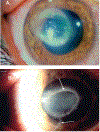The biology of Acanthamoeba keratitis
- PMID: 33221372
- PMCID: PMC7856181
- DOI: 10.1016/j.exer.2020.108365
The biology of Acanthamoeba keratitis
Abstract
Acanthamoeba keratitis (AK) is a rare protozoal infection of the cornea. At least eight species of Acanthamoeba are known to cause this sight-threatening disease of the ocular surface. Acanthamoeba spp. exist in a wide array of niches ranging from thermal springs to under ice and every conceivable habitat in between. Contact lens wear is the leading risk factor for AK and is practiced by over 30 million individuals in the United States, yet the incidence of AK is less than 33 cases per one million contact lens wearers. Serological studies have reported that 90%-100% of individuals with no history of AK possess antibodies specific for Acanthamoeba antigens indicating that exposure to this organism is commonplace, yet disease is remarkably rare. Animal studies have shed light on the pathobiology and immunobiology of AK and indicate that a constellation of factors including the ocular surface microbiome and the microbiome of Acanthamoeba itself contribute to the pathogenesis of AK. Interesting, secretory antibodies produced by the adaptive immune response can prevent the initiation of corneal infection, but once Acanthamoeba trophozoites breach the corneal epithelium the adaptive immune system is helpless in altering the course of AK. It has been almost 50 years since AK was first described, yet many questions remain unanswered about this curious and enigmatic disease of the ocular surface.
Keywords: Acanthamoeba; Contact lens; Cornea; Immunology; Keratitis; Microbiome; Pathology.
Copyright © 2020 Elsevier Ltd. All rights reserved.
Figures


Similar articles
-
Epidemiology of and Genetic Factors Associated with Acanthamoeba Keratitis.Pathogens. 2024 Feb 4;13(2):142. doi: 10.3390/pathogens13020142. Pathogens. 2024. PMID: 38392880 Free PMC article. Review.
-
Increasing incidence of contact-lens-related Acanthamoeba keratitis in a tertiary ophthalmology department in an Italian population.Eur J Ophthalmol. 2024 Nov;34(6):1875-1883. doi: 10.1177/11206721241242165. Epub 2024 Mar 20. Eur J Ophthalmol. 2024. PMID: 38509758
-
Pathobiology and Immunobiology of Acanthamoeba Keratitis: Insights from Animal Models .Yale J Biol Med. 2017 Jun 23;90(2):261-268. eCollection 2017 Jun. Yale J Biol Med. 2017. PMID: 28656012 Free PMC article. Review.
-
The diagnosis and management of Acanthamoeba keratitis.CLAO J. 2000 Jan;26(1):47-51. CLAO J. 2000. PMID: 10656311 Review.
-
Assessment of Confocal Microscopy for the Diagnosis of Polymerase Chain Reaction-Positive Acanthamoeba Keratitis: A Case-Control Study.Ophthalmology. 2018 Feb;125(2):161-168. doi: 10.1016/j.ophtha.2017.08.037. Epub 2017 Sep 29. Ophthalmology. 2018. PMID: 28965660
Cited by
-
Impact of First Healthcare Provider on Acanthamoeba Keratitis Course: How to Overcome Poor Prognosis in Acanthamoeba Keratitis Treatment? A Single Tertiary Center, Observational Study.Clin Ophthalmol. 2023 Dec 21;17:3975-3982. doi: 10.2147/OPTH.S438990. eCollection 2023. Clin Ophthalmol. 2023. PMID: 38146454 Free PMC article.
-
Silver Nanoparticles Conjugated with Contact Lens Solutions May Reduce the Risk of Acanthamoeba Keratitis.Pathogens. 2021 May 11;10(5):583. doi: 10.3390/pathogens10050583. Pathogens. 2021. PMID: 34064555 Free PMC article.
-
Tannic Acid-Modified Silver Nanoparticles in Conjunction with Contact Lens Solutions Are Useful for Progress against the Adhesion of Acanthamoeba spp. to Contact Lenses.Microorganisms. 2022 May 24;10(6):1076. doi: 10.3390/microorganisms10061076. Microorganisms. 2022. PMID: 35744595 Free PMC article.
-
Successive Acanthamoeba Corneal Isolates Identified in Poland Monitored in Terms of In Vitro Dynamics.Microorganisms. 2023 Apr 29;11(5):1174. doi: 10.3390/microorganisms11051174. Microorganisms. 2023. PMID: 37317148 Free PMC article.
-
Exploring LSU and ITS rDNA Sequences for Acanthamoeba Identification and Phylogeny.Microorganisms. 2022 Sep 3;10(9):1776. doi: 10.3390/microorganisms10091776. Microorganisms. 2022. PMID: 36144378 Free PMC article.
References
-
- Adams LB, Pena MT, Sharma R, Hagge DA, Schurr E, Truman RW, 2012. Insights from animal models on the immunogenetics of leprosy: a review. Mem Inst Oswaldo Cruz 107 Suppl 1, 197–208. - PubMed
-
- Aksozek A, McClellan K, Howard K, Niederkorn JY, Alizadeh H, 2002. Resistance of Acanthamoeba castellanii cysts to physical, chemical, and radiological conditions. J Parasitol 88, 621–623. - PubMed
-
- Alizadeh H, Apte S, El-Agha M-SH, Li L, Hurt M, Howard K, Cavanagh HD, McCulley JP, Niederkorn JY, 2001. Tear IgA and serum IgG antibodies against Acanthmaoeba in patients with Acanthamoeba keratitis. Cornea. - PubMed
-
- Alizadeh H, He Y, McCulley JP, Ma D, Stewart GL, Via M, Haehling E, Niederkorn JY, 1995. Successful immunization against Acanthamoeba keratitis in a pig model. Cornea 14, 180–186. - PubMed
Publication types
MeSH terms
Substances
Grants and funding
LinkOut - more resources
Full Text Sources
Other Literature Sources
Medical
Miscellaneous

